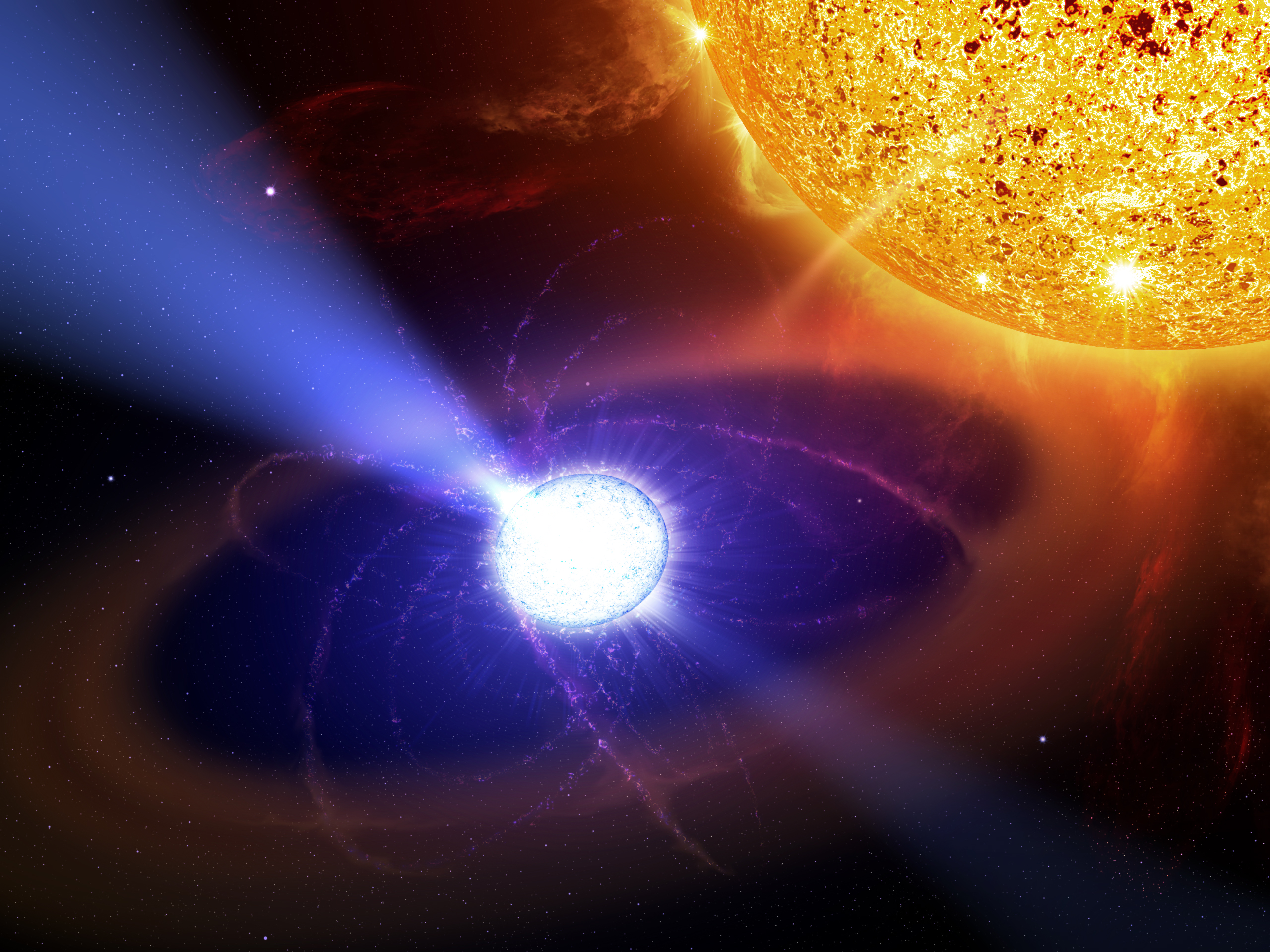|
AR Scorpii
AR Scorpii (AR Sco) is a binary pulsar that consists of a white dwarf and a red dwarf. It is located close to the ecliptic plane in the constellation Scorpius. Parallax measurements made by ''Gaia'' put the system at a distance of about 380 light-years (120 parsecs). AR Scorpii is the first "white dwarf-pulsar" to be discovered. Its unusual nature was first noticed by amateur astronomers. The 3.56-hour period in AR Scorpii's light curve caused it to be misclassified as a Delta Scuti variable, but in 2016, this period was found to be the binary orbital period. In addition, the system shows very strong optical, ultraviolet, and radio pulsations originating from the red dwarf with a period of just 1.97 minutes, which is a beat period from the orbital rotation and the white dwarf spin. These pulsations occur when a relativistic beam from the white dwarf sweeps across the red dwarf, which then reprocesses the beam into the observed electromagnetic energy. Although the whi ... [...More Info...] [...Related Items...] OR: [Wikipedia] [Google] [Baidu] |
Binary Stars
A binary star or binary star system is a system of two stars that are gravitationally bound to and in orbit around each other. Binary stars in the night sky that are seen as a single object to the naked eye are often resolved as separate stars using a telescope, in which case they are called ''visual binaries''. Many visual binaries have long orbital periods of several centuries or millennia and therefore have orbits which are uncertain or poorly known. They may also be detected by indirect techniques, such as spectroscopy (''spectroscopic binaries'') or astrometry (''astrometric binaries''). If a binary star happens to orbit in a plane along our line of sight, its components will eclipse and transit each other; these pairs are called ''eclipsing binaries'', or, together with other binaries that change brightness as they orbit, ''photometric binaries''. If components in binary star systems are close enough, they can gravitationally distort each other's outer stellar atmospheres. ... [...More Info...] [...Related Items...] OR: [Wikipedia] [Google] [Baidu] |
Pulsars
A pulsar (''pulsating star, on the model of quasar'') is a highly magnetized rotating neutron star that emits beams of electromagnetic radiation out of its magnetic poles. This radiation can be observed only when a beam of emission is pointing toward Earth (similar to the way a lighthouse can be seen only when the light is pointed in the direction of an observer), and is responsible for the pulsed appearance of emission. Neutron stars are very dense and have short, regular rotational periods. This produces a very precise interval between pulses that ranges from milliseconds to seconds for an individual pulsar. Pulsars are one of the candidates for the source of ultra-high-energy cosmic rays (see also centrifugal mechanism of acceleration). Pulsars’ highly regular pulses make them very useful tools for astronomers. For example, observations of a pulsar in a binary neutron star system were used to indirectly confirm the existence of gravitational radiation. The first ext ... [...More Info...] [...Related Items...] OR: [Wikipedia] [Google] [Baidu] |
White Dwarfs
A white dwarf is a stellar core remnant composed mostly of electron-degenerate matter. A white dwarf is very dense: in an Earth sized volume, it packs a mass that is comparable to the Sun. No nuclear fusion takes place in a white dwarf; what light it radiates is from its residual heat. The nearest known white dwarf is Sirius B, at 8.6 light years, the smaller component of the Sirius binary star. There are currently thought to be eight white dwarfs among the hundred star systems nearest the Sun. The unusual faintness of white dwarfs was first recognized in 1910. The name ''white dwarf'' was coined by Willem Jacob Luyten in 1922. White dwarfs are thought to be the final evolutionary state of stars whose mass is not high enough to become a neutron star or black hole. This includes over 97% of the stars in the Milky Way. After the hydrogen- fusing period of a main-sequence star of low or intermediate mass ends, such a star will expand to a red giant and fuse helium to ca ... [...More Info...] [...Related Items...] OR: [Wikipedia] [Google] [Baidu] |
M-type Main-sequence Stars
Type M or M type may refer to: Science and technology * Type M, a xD-Picture Card * Type M, a name for the 15 amp BS 546 electrical plug * Vaio Type M, a kind of Vaio computer from Sony * M-type asteroid * m-type filter, an electronic filter * M-type star * M-types, an implementation of inductive type In type theory, a system has inductive types if it has facilities for creating a new type from constants and functions that create terms of that type. The feature serves a role similar to data structures in a programming language and allows a ty ... Other uses * Audi Type M, a 1920s car * Beretta 92FS Compact Type M, a pistol * MG M-type, a sports car See also * M class (other) * Class M (other) {{disambiguation ... [...More Info...] [...Related Items...] OR: [Wikipedia] [Google] [Baidu] |
AAVSO
The American Association of Variable Star Observers (AAVSO) is an international nonprofit organization. Founded in 1911, the organization focuses on coordinating, analyzing, publishing, and archiving variable star observations made largely by amateur astronomers. The AAVSO creates records that establish light curves depicting the variation in brightness of a star over time. The AAVSO makes these records available to professional astronomers, researchers, and educators. Professional astronomers do not have the resources to monitor every variable star. Hence, astronomy is one of the few sciences where amateurs can make significant contributions to research. In 2011, the 100th year of the AAVSO's existence, the twenty-millionth variable star observation was received into their database. The AAVSO International Database (AID) has stored over thirty-five million observations as of 2019. The organization receives nearly 1,000,000 observations annually from an estimated amount of 2,000 ... [...More Info...] [...Related Items...] OR: [Wikipedia] [Google] [Baidu] |
Pulsar
A pulsar (''pulsating star, on the model of quasar'') is a highly magnetized rotating neutron star that emits beams of electromagnetic radiation out of its Poles of astronomical bodies#Magnetic poles, magnetic poles. This radiation can be observed only when a beam of emission is pointing toward Earth (similar to the way a lighthouse can be seen only when the light is pointed in the direction of an observer), and is responsible for the pulsed appearance of emission. Neutron stars are very density, dense and have short, regular rotational Period (physics), periods. This produces a very precise interval between pulses that ranges from milliseconds to seconds for an individual pulsar. Pulsars are one of the candidates for the source of ultra-high-energy cosmic rays (see also centrifugal mechanism of acceleration). Pulsars’ highly regular pulses make them very useful tools for astronomers. For example, observations of a pulsar in a PSR B1913+16, binary neutron star system were use ... [...More Info...] [...Related Items...] OR: [Wikipedia] [Google] [Baidu] |
AE Aquarii
AE Aquarii is a cataclysmic variable binary star of the DQ Herculis variable, DQ Herculis type. Based upon parallax measurements, the system is located at a distance of about from the Earth. Because of its unique properties, this system has been subject to a number of scientific studies. The white dwarf in the AE Aquarii system is the first star of its type known to give off pulsar-like pulsations that are powered by its rotation and particle acceleration. Arno Arthur Wachmann discovered that the star was variable after examining four photographic plates taken from 1923 through 1930. He classified the star as a mira variable based on that sparse data set. Wachmann published the discovery in 1931, naming the star 342.1931 Aquarii. In 1938, Ernst Zinner classified the star, which by then had received the variable star designation AE Aquarii, as a cataclysmic variable, based upon a much larger data set. The AE Aquarii system consists of an ordinary star in a close orbit ... [...More Info...] [...Related Items...] OR: [Wikipedia] [Google] [Baidu] |
Earth
Earth is the third planet from the Sun and the only astronomical object known to Planetary habitability, harbor life. This is enabled by Earth being an ocean world, the only one in the Solar System sustaining liquid surface water. Almost all of Earth's water is contained in its global ocean, covering Water distribution on Earth, 70.8% of Earth's crust. The remaining 29.2% of Earth's crust is land, most of which is located in the form of continental landmasses within Earth's land hemisphere. Most of Earth's land is at least somewhat humid and covered by vegetation, while large Ice sheet, sheets of ice at Polar regions of Earth, Earth's polar polar desert, deserts retain more water than Earth's groundwater, lakes, rivers, and Water vapor#In Earth's atmosphere, atmospheric water combined. Earth's crust consists of slowly moving tectonic plates, which interact to produce mountain ranges, volcanoes, and earthquakes. Earth's outer core, Earth has a liquid outer core that generates a ... [...More Info...] [...Related Items...] OR: [Wikipedia] [Google] [Baidu] |
Accretion (astrophysics)
In astrophysics, accretion is the accumulation of particles into a massive object by gravity, gravitationally attracting more matter, typically gaseous matter, into an accretion disk. Most astronomical objects, such as galaxy, galaxies, stars, and planets, are formed by accretion processes. Overview The accretion model that Earth and the other terrestrial planets formed from meteoric material was proposed in 1944 by Otto Schmidt, followed by the ''protoplanet theory'' of William McCrea (astronomer), William McCrea (1960) and finally the ''capture theory'' of Michael Woolfson. For details of Kant's position, see In 1978, Andrew Prentice resurrected the initial Laplacian ideas about planet formation and developed the ''modern Laplacian theory''. None of these models proved completely successful, and many of the proposed theories were descriptive. The 1944 accretion model by Otto Schmidt was further developed in a quantitative way in 1969 by Viktor Safronov. He calculated, in deta ... [...More Info...] [...Related Items...] OR: [Wikipedia] [Google] [Baidu] |
Beat (acoustics)
In acoustics, a beat is an interference pattern between two sounds of slightly different frequencies, ''perceived'' as a periodic variation in volume whose rate is the difference of the two frequencies. With tuning instruments that can produce sustained tones, beats can be readily recognized. Tuning two tones to a unison will present a peculiar effect: when the two tones are close in pitch but not identical, the difference in frequency generates the beating. The volume varies as in a tremolo as the sounds alternately interfere constructively and destructively. As the two tones gradually approach unison, the beating slows down and may become so slow as to be imperceptible. As the two tones get further apart, their beat frequency starts to approach the range of human pitch perception, the beating starts to sound like a note, and a combination tone is produced. Mathematics and physics of beat tones This phenomenon is best known in acoustics or music, though it can be found in ... [...More Info...] [...Related Items...] OR: [Wikipedia] [Google] [Baidu] |








